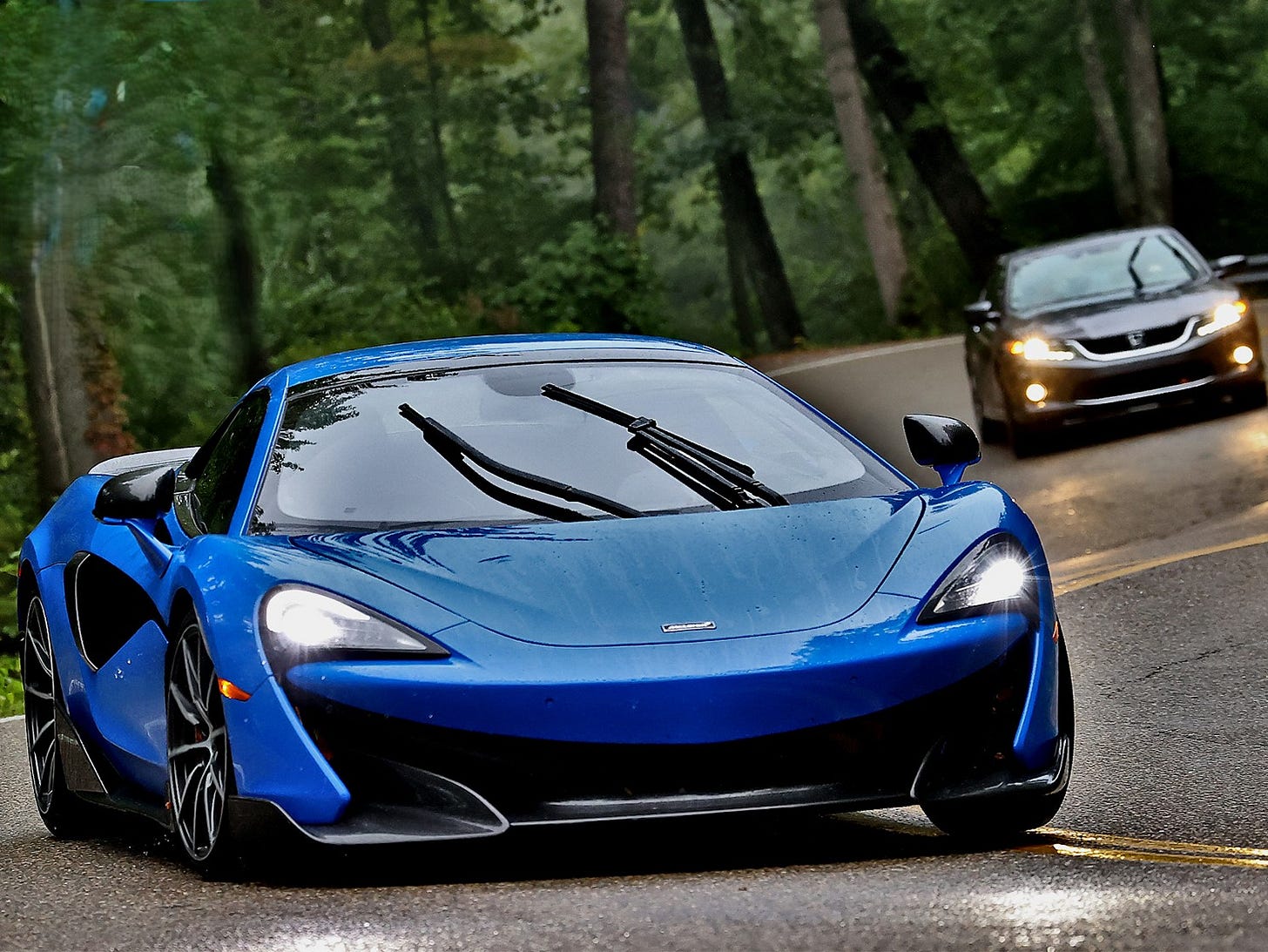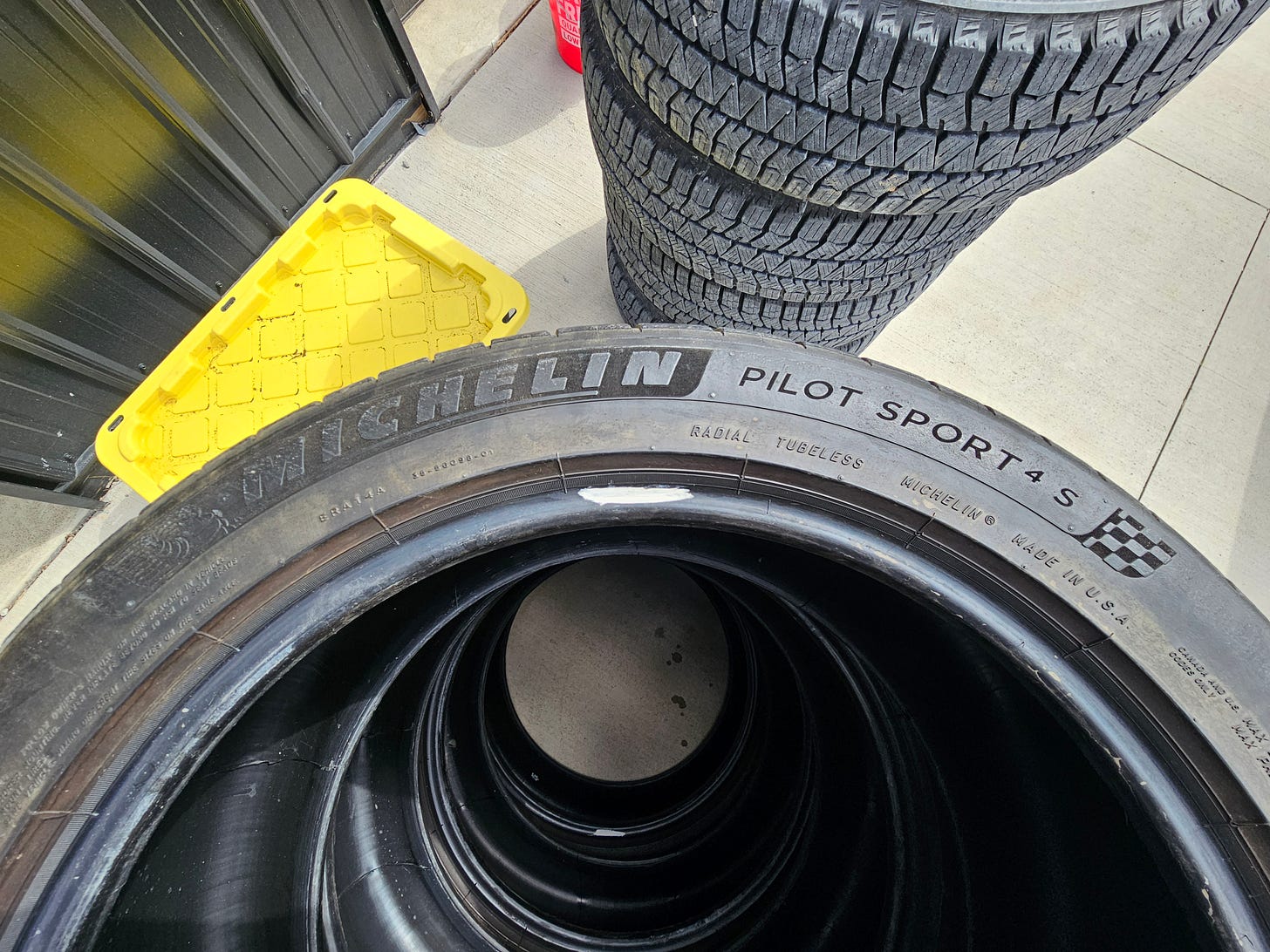"Great tires," he mused, "not just good ones."
All subscribers welcome
In the end, when it is over, all of our debts are paid, whether via our presence or by our absence. And how often, between now and then, do we wake to discover that we are no longer really the person who incurred those debts in the first place? Or that our creditor, as well, has changed into someone or something who no longer needs to be satisfied, or no longer wishes to be, or no longer can be?
Well, that’s an odd way to start what should be a straightforward long-term tire test, isn’t it. I will explain. Five years ago, I agreed to accompany two executives of my then-current employer on a drive at the Tail Of The Dragon. One of them had been provided a McLaren 600LT, just a lovely car, and well above his ability to operate. The other had been provided with a Lotus Evora 400, also a lovely car.
I had my 2014 Accord “6-6”, provided to me by me and for which I’d recently received a free and clear title. It was a little short on both tires and brakes, so I did the most auto-journo thing possible, although at the time I was earning a robust $221,000 a year plus bonus: I begged various people for tires and brakes. A friend at Hawk came up with free pads. At Summit Racing I paid a discounted rate for rotors and fluid. Another friend, a gregarious and universally-liked New Yorker with the Michelin account, sent me the new Michelin Pilot 4S tires in 245/45ZR18 instead of the factory 235/40ZR18. And off to the Dragon I went.
From the first mile I was really charmed by the Michelins. In the dry they had serious grip and made very little noise, an important quality in a car mostly distinguished from the Acura TL by a complete and total lack of insulation or sound deadening. In the wet, they were what the kids call a “cheat code”. It rained off and on during our trips through the Dragon, but the 4S developed so much grip that my passenger, who can identify himself if he likes but is not required to, finally asked me to slow down. This was not a man known for being a nervous passenger, yet he was alternately befuddled and terrified by how much wet grip the Accord could generate.
In the rain, the supercars were easy meat — but even once it dried out, I had the measure of both drivers in both cars. I could have passed both of them at any time and had they not been basically the signers on my paycheck I’d have done it just for the lulz. Not until we reached the Cherohala Skyway were they able to just motor away from the Michelin-shod Accord — but on the 100mph-plus corners up there, I had no trouble coming back for a look.

At the end of the trip, most memorable for an incident in which one of the executives bragged at lunch about being trained by some ex-IDF guys at some rich-dude camp — “It was just like real combat!” he exclaimed, while I pinched my own leg black and blue to keep from laughing — the free cars went back home but the free Michelins stayed on my car. Subsequently I mentioned the tires in an article, which satisfied the very modest obligation laid on me by the PR fellow. At the time I struggled with what to write about the Michelin Pilot 4S, because as far as I could tell it had no obvious weakness as a product, and I hate to write stuff that reads like advertising copy.
That was about 75,000 miles ago, minus maybe 18,000 miles put on dedicated snow tires during that time. So fifty thousand miles and more, easy. This past week, in anticipation of giving my Accord to my son for a while, I had them removed and replaced with the considerably less enthusiastic, but definitely more teenager-appropriate, Goodyear WeatherReady. As I am no longer any sort of autojourno, I paid full price for those.
Which means now is a good time to review these tires and give them the credit they’re due. I don’t know anyone at Michelin anymore and they certainly don’t want to know me — but in these degraded and often desperate modern times, full credit should be given whenever someone or something is truly excellent, as these tires were and are. In no particular order, their virtues:
They never got loud. Not even when they were on the wear bars.
I hit two of the four OZ Italia wheels hard enough to bend them, one quite badly, but in both cases the Michelins continued to hold air.
The dry grip stayed excellent to the very end, with about the drop you’d expect from, say, the first session of a Toyo RA-1 to the tenth. Which is to say: not much.
Wet grip was always good from a raw tread-compound perspective, although they obviously became less resistant to hydroplaning after they hit the wear bars.
Speaking of wear: these grip almost like the best 200tw tires while in actuality lasting like 500tw tires.
I put hundreds of racetrack laps on them. Hundreds. Often with one or both front wheels spinning a bit. The grip stayed predictable and strong. I drove around a lot of very nice cars, with not-so-awful drivers, using my old Accord and three-year-old Michelins. As late as last spring I could maintain corner speeds to match new factory sporting cars on their OEM-provided rubber. At that point the tires had been through four outdoor storage winters.
I made repeated excursions up to 130mph or slightly above and never saw any wear or heat issues, as recently as fall of 2024.
They were flatly impervious to road hazards and never did so much as catch a screw or sharp rock during their duty cycle.
They look super cool. Which isn’t really important, but it is kind of important.
They were made in the United States. Not all Pilot 4S tires are. Some are made in France, which I’d imagine is also a good place to make Michelins.
Rarely have I operated a more predictable tire. You could three-wheel the big Honda on the street any time you wanted to. I never worried about putting it sideways, either on road or track, because the sidewalls were so communicative. I’d liken it to the Direzza Star Specs or the RE-71RS in terms of letting you know what’s happening with the tread blocks, even if the actual grip is a class below those 200tw entries.
I had a rear wheel bearing go very bad last year, and by all rights it should have trashed the tire on that corner, but all it did was feather the tread blocks a bit, said feathering disappearing after two weeks on a new hub.
Just last month I put the completely smoked Michelins through the equivalent of the Swedish “moose test” when a calico kitten wandered out onto Ohio Route 314 while I was absolutely cooking along. (I blame that new band, The Last Dinner Party, and their suspiciously seductive-to-old-men rock music.) Happy to report the kitten lived to make bad decisions another day, which is more than can be said about the hamburger I was holding at the time.
The Michelin Pilot 4S is often the most expensive summer tire, or one of the most expensive tires, at any given size. I’m here to tell you that it’s absolutely worth it. Were the Accord staying in my custody, instead of going to The Commander, I’d likely have sacked up the additional $570 it would have cost to choose them again. Rarely in my life have I been so completely satisfied with an item that is meant to wear out and go away.
As noted before, I no longer have any contacts at Michelin and I doubt they’ll see this article. Nor do I ever expect to be working in the Favor Bank Of Autowriting. I owe no debts to PR, to friends, to future opportunities. And I can barely remember being the person who incurred those debts in the first place. It’s been a long five years and whatever exuberance I used to display, whatever casual arrogance that marked my correspondence and mode of address… all of that is gone, burned out beyond recovery.
There’s really just one debt left to pay: to you, the ACF reader. This is a good tire. You should know about it. If I find any more good tires, I’ll be sure to let you know about them, as well. In the meantime, if you’re shopping, I don’t think you can do any better than the Michelin Pilot 4S. I’d give it three stars. Three Michelin stars. Which, for those of you who don’t have your lives and identities wrapped up in what you digest and excrete, means it’s the very best.





Honestly, it would be fun and worthwhile to have a general tire guide post. Structure as a loquacious shitpost but with serious pros/cons for track/autocross, performance, and everyday tires.
As an example; what will you put on the wheels of the 300C when its factory rubber date-codes out? What would you put on the rear wheels of a corvette with more than 600 hp used for Racing In Mexico? What did you run in the Singer Milan (so long as cost was not a factor) etc, etc...
I have used the predecessor tire (Pilot Super Sport), the tire in question, as well as the successor tire (Pilot Sport 5). I think the PS5 offers more “performance” than the Pilot Sport Cup 2, in fact.
I would be hard pressed to consider any other brand, even on a vehicle for which Michelin was not among the OEM tire options.